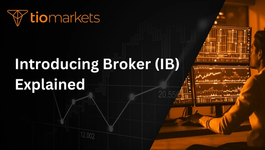Deep discount bond: Explained | TIOmarkets
BY TIOmarkets
|July 4, 2024In the world of trading, a deep discount bond is a term that is often used but seldom fully understood. This article aims to demystify the concept, providing a comprehensive explanation of what a deep discount bond is, its characteristics, how it functions, and its implications for traders and investors alike.
Whether you're a seasoned trader or a novice in the field, understanding the intricacies of financial instruments such as deep discount bonds is crucial. This knowledge can help you make informed decisions, manage risks effectively, and maximize your potential returns. So, let's delve into the fascinating world of deep discount bonds.
Understanding Deep Discount Bonds
A deep discount bond, as the name suggests, is a bond that is sold at a significant discount to its face value. The 'deep discount' refers to the large difference between the purchase price of the bond and its face value, which is the amount the bondholder will receive upon the bond's maturity.
These bonds do not pay interest periodically like traditional bonds. Instead, the return for the investor comes from the difference between the discounted purchase price and the face value paid at maturity. This difference is known as the bond's yield to maturity (YTM).
Characteristics of Deep Discount Bonds
Deep discount bonds have several distinctive characteristics that set them apart from other types of bonds. Firstly, they are issued at a price significantly lower than their face value. This is the 'deep discount' that gives these bonds their name.
Secondly, deep discount bonds do not pay periodic interest or coupon payments. Instead, the investor's return is the difference between the purchase price and the face value of the bond at maturity. This makes deep discount bonds a type of 'zero-coupon bond'.
How Deep Discount Bonds Work
When a deep discount bond is issued, the investor purchases the bond at a price significantly lower than its face value. The bond does not pay any interest during its term. Instead, when the bond matures, the investor receives the face value of the bond.
The return for the investor, therefore, is the difference between the purchase price and the face value. This difference, expressed as a percentage of the purchase price, is the bond's yield to maturity (YTM). The YTM is effectively the interest rate that the investor earns on the bond.
The Role of Deep Discount Bonds in Trading
Deep discount bonds play a significant role in trading and investment strategies. They offer a way for investors to earn a return on their investment without the need for periodic interest payments. This can be particularly attractive for investors who do not need regular income from their investments and are willing to wait until the bond's maturity to realize their return.
Furthermore, deep discount bonds can offer a higher yield to maturity than other types of bonds. This is because the discount on the purchase price can result in a higher return when the bond matures. However, this potential for higher returns comes with a higher level of risk, as the investor must wait until maturity to realize their return and the bond's issuer must remain solvent until then.
Deep Discount Bonds and Risk Management
Like all financial instruments, deep discount bonds come with their own set of risks. The most significant of these is the risk that the issuer of the bond will default, or fail to pay the face value of the bond at maturity. This is known as credit risk.
However, deep discount bonds can also play a role in risk management strategies. Because they do not pay periodic interest, they are less sensitive to changes in interest rates than other types of bonds. This can make them a useful tool for hedging against interest rate risk.
Deep Discount Bonds and Portfolio Diversification
Deep discount bonds can also play a role in portfolio diversification strategies. Because they behave differently to other types of bonds and other financial instruments, they can help to spread risk and potentially enhance returns.
For example, in a falling interest rate environment, the value of deep discount bonds can increase significantly, providing a boost to portfolio returns. Conversely, in a rising interest rate environment, the value of deep discount bonds can decrease. However, this can be offset by gains in other parts of the portfolio.
Trading Deep Discount Bonds
Trading deep discount bonds involves buying and selling these bonds in the secondary market. Traders aim to profit from changes in the price of the bonds, rather than waiting for the bonds to mature.
When trading deep discount bonds, it's important to understand the factors that can affect the price of the bonds. These can include changes in interest rates, changes in the creditworthiness of the bond's issuer, and changes in market sentiment.
Strategies for Trading Deep Discount Bonds
There are several strategies that traders can use when trading deep discount bonds. One common strategy is to buy the bonds when interest rates are high and sell them when interest rates fall. This is because the price of deep discount bonds tends to increase when interest rates fall.
Another strategy is to buy deep discount bonds issued by companies that are expected to improve their creditworthiness. If the company's credit rating improves, the price of its bonds is likely to increase.
Challenges in Trading Deep Discount Bonds
Trading deep discount bonds can be challenging, due to the complexity of these financial instruments and the risks involved. One of the main challenges is assessing the credit risk of the bond's issuer. This requires a deep understanding of the issuer's financial situation and the factors that could affect its ability to pay the face value of the bond at maturity.
Another challenge is predicting changes in interest rates, which can have a significant impact on the price of deep discount bonds. This requires a good understanding of economic indicators and monetary policy.
Conclusion
Deep discount bonds are a fascinating and complex financial instrument that can play a significant role in trading and investment strategies. They offer potential for high returns, but also come with their own set of risks.
Understanding these risks and how to manage them is crucial for anyone trading or investing in deep discount bonds. With a solid understanding of these bonds and the factors that affect their price, traders and investors can make informed decisions and potentially achieve impressive returns.
Start Trading Deep Discount Bonds with TIOmarkets
Ready to put your knowledge of deep discount bonds into action? Join TIOmarkets, the top-rated forex broker, and expand your trading portfolio to include over 300 instruments across 5 markets. With low fees and a wealth of educational resources, we empower you to trade Forex, indices, stocks, commodities, and futures markets effectively. Become one of the 170,000+ traders from over 170 countries who have already started their journey with us. Create a Trading Account today and take the first step towards potentially impressive returns.

Risk disclaimer: CFDs are complex instruments and come with a high risk of losing money rapidly due to leverage. You should consider whether you understand how CFDs work and whether you can afford to take the high risk of losing your money. Never deposit more than you are prepared to lose. Professional client’s losses can exceed their deposit. Please see our risk warning policy and seek independent professional advice if you do not fully understand. This information is not directed or intended for distribution to or use by residents of certain countries/jurisdictions including, but not limited to, USA & OFAC. The Company holds the right to alter the aforementioned list of countries at its own discretion.
Join us on social media

Behind every blog post lies the combined experience of the people working at TIOmarkets. We are a team of dedicated industry professionals and financial markets enthusiasts committed to providing you with trading education and financial markets commentary. Our goal is to help empower you with the knowledge you need to trade in the markets effectively.





